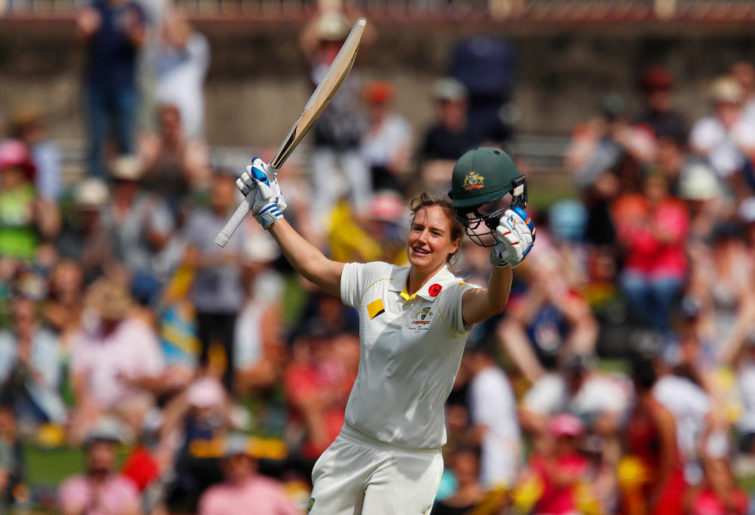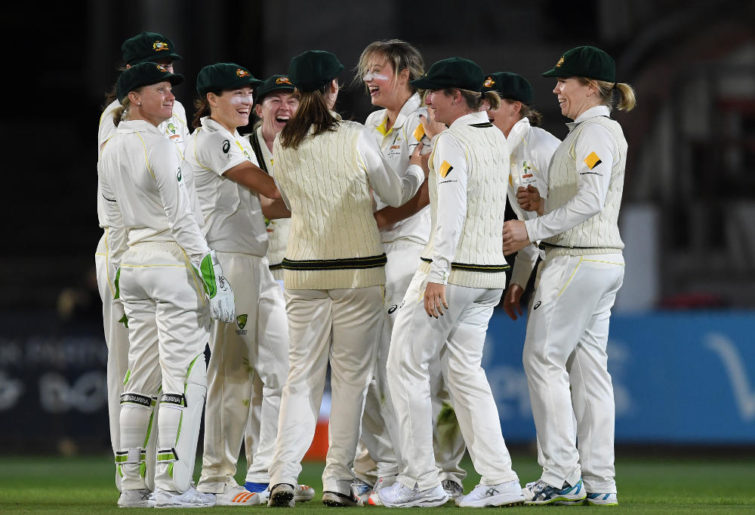Early on Monday morning the sole Test match in the Women’s Ashes was declared a draw in Taunton.
With that declaration, the Australian women’s cricket team can officially celebrate retaining the Ashes with the team holding an 8-2 lead in the series heading into the final format, the three T20Is which will commence on Friday.
Even if England were to win all three T20Is, with each victory only worth two points, the most that England can hope to do is draw the series. A drawn series would result in Australia, as the reigning champions, retaining the trophy.
It’s been two years since the Aussie women last had the opportunity to play Test cricket and just like the last time these two teams faced each other back in the 2017 Ashes series, there were many special moments.
Three Australian women received their first baggy greens – all rounders Ashleigh Gardner and Sophie Molineaux and 20-year-old right-arm quick, Tayla Vlaeminck. It was an incredible achievement for all three women who have each faced challenges getting to this point, but in particular Molineaux who a week and a half ago was not even in the Ashes squad. Instead, she featured as part of the Australia A squad while she completed recovery from a shoulder reconstruction she had earlier this year.
Then to the Test match itself.
In Australia’s first innings with the bat, several women reached batting milestones. There were half centuries from Alyssa Healy (58) and Meg Lanning (57). For Healy, that was her maiden Test half century and made her the first female Aussie opener to hit a Test fifty since Alex Blackwell back in 2009.
Heading into day two, many of us waited with bated breath to see if Ellyse Perry would score another Test century. Heading into the day’s play she had scored 297 runs from 579 deliveries since she was last dismissed in Test cricket eclipsing the former record of 285 which was held by Emily Drumm.
She also became the first woman since 1986 (and just the seventh woman) to score more than 500 runs and take more than 25 wickets in Test match cricket.
Early on day 2 Perry reached triple figures. When she lifted her bat in the air she had scored 313 runs from 620 balls without being dismissed in Test cricket. Her dad, Mark and her mum, Kathy were also in the crowd to cheer her on.

Australia’s Ellyse Perry performances were a highlight of the Women’s Ashes. (AAP Image/Daniel Munoz)
This century made her just one of only four women to have scored back-to-back Test hundreds. Her name will forever be etched into the history books alongside fellow Australian Betty Wilson (1958) and Englishwomen Enid Bakewell (1969) and Claire Taylor (2003).
Rachael Haynes also scored a half century and fell just 13 runs short of scoring her maiden century. It was her second highest Test score, coming ten years and nine days after she hit 98 on Test debut in Worcester. Funnily enough, it was England’s Laura Marsh who got her out on both occasions.
Beth Mooney also brought up her maiden Test half century.
England only came in to bat on day three and Sophie Molineaux on debut was impressive. She took the key wickets of Heather Knight, Amy Jones and Sarah Taylor which pushed England in a position of 5-132. Sophie bowled 29 of the 83 overs faced by England for figures of 3-71, including five maidens.
The last time the Aussie women competed in a Test, I had the opportunity to be there and see Perry make her double century.
While that was probably one of the best sporting moments I had ever witnessed, at the time I reflected that it also filled me with a sense of sadness. That Test in 2017 was Perry’s first Test century; can you imagine what this woman could achieve if she was given the opportunity to play more Test cricket?
At the conclusion of this Test match, I felt a similar sense of sadness.
Over the weekend I expressed some mild frustration that Australia’s tactics seemed to have changed. Leading into the Test match both Australia and England made their intentions clear; they wanted to win the Test match. But play suggested anything but.
Australia was still batting at the end of day two. At this point, I felt like a draw was imminent. With three innings left to play in just two days, I wondered how Australia would do it?
Had Australia wanted a result, my guess would have been that they would have declared early on day two and then put England under pressure (which I imagine Australia could have done given how potent their batting attack has been through the series).
But then, an article by Geoff Lemon made me reflect.
The Aussie women only get the chance to play Test match cricket every two years. Given how limited the opportunities are, I can understand why the batters were given the opportunity to reach their significant milestones.
The bottom line is, we need more opportunity for women to play Test cricket so that this form of the game is not as much of an outlier. We need more countries playing Test cricket and additionally, the Test matches need to be played for five days, not four.
Then there’s the other elephant in the room – one which we’ve watched play out during the series.
Australia have dominated England from the first ODI on.
Last time these two teams met in an Ashes series, it was competitive. But given that England has not kept up with Australia’s increased professionalisation of the women’s game, the gap appears to be widening.
While there is support for the English women’s team, the domestic structure does not exist to support these elite cricketers like it does in Australia through the WNCL and the WBBL.
I wonder what this means for the future of international women’s cricket. It is clear what needs to happen. The other countries need to push professionalism and give their female cricketers increased opportunity to be professional or semi-professional. If this does not happen, the gap will continue to widen.

We need more women’s Test cricket (AAP Image/Dean Lewins)
And that would be a shame – because if the professionalisation of the Aussie women has shown anything, it’s how much talent exists. When this talent is fostered and encouraged, the results speak for themselves.
The last thing we want is a dominant Australia with no opposition to face them. As much as I love to see Australia win, it is increasingly important that the standard continues to lift across the board. In the end, this will yield the greatest benefit of all for women’s cricket.






























































































